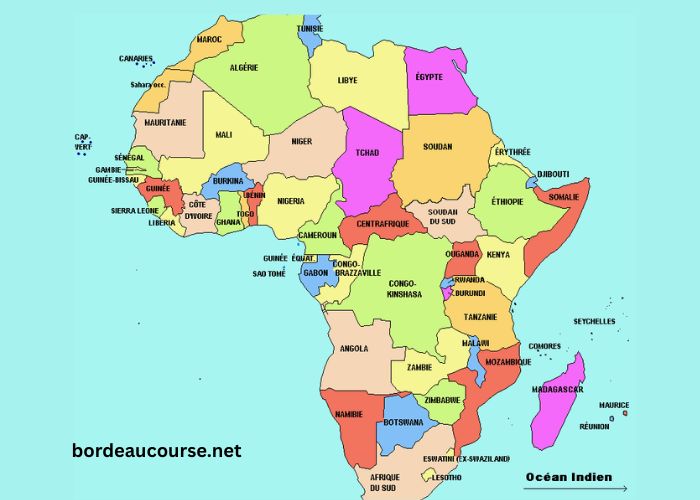Africa, the second-largest continent in the world, boasts an extraordinary diversity of countries, languages, and landscapes. A Carte DE L’afrique (map of Africa) serves as a valuable resource for anyone looking to explore the geography, cultures, and history of this vibrant continent.
Understanding the Carte DE L’afrique provides insight into Africa’s vast natural beauty and complex socio-political structures. From deserts to rainforests, from bustling cities to remote villages, the map is an indispensable tool for both educators and travelers alike.
What Is Carte DE L’afrique?
A Carte DE L’afrique is a map that represents the continent of Africa, showing its countries, borders, major cities, rivers, mountains, and other geographical features. Maps like these are crucial for understanding the layout and physical characteristics of Africa, allowing users to navigate the continent with ease. With over 50 countries, Africa’s map reveals the intricate boundaries that divide and define the regions, each with its own distinct identity.
The Carte DE L’afrique helps individuals learn about Africa’s geography by providing a visual representation of its diverse landscapes, from the Sahara Desert in the north to the lush rainforests in Central Africa. It also helps in identifying major landmarks, including the Nile River, Mount Kilimanjaro, and the Congo Basin. The map serves as a gateway to understanding the immense geographical diversity that shapes Africa.
How Is Carte DE L’afrique Useful for Travelers?
For travelers, a Carte DE L’afrique offers valuable insights into the continent’s diverse regions. Africa’s geography is as varied as its cultures, and having a clear map enables visitors to plan their journeys, whether they’re headed to the coastal beaches of Egypt or the savannahs of Kenya. A detailed Carte DE L’afrique helps to identify popular tourist destinations, important cities, and natural wonders that may be of interest during a trip.
When traveling across Africa, understanding the continent’s geography with the help of a Carte DE L’afrique is crucial for efficient travel planning. Whether it’s an adventure tour through Southern Africa or exploring the ancient ruins of North Africa, the map provides the knowledge needed to make informed decisions about transportation, safety, and cultural exploration. Thus, a Carte DE L’afrique is not only an educational tool but also a practical guide for adventurers.
What Are the Key Features of a Carte DE L’afrique?
A Carte DE L’afrique typically includes several key features that help users better understand Africa’s landscape. These maps are often detailed, showing countries, borders, cities, and major roads, which are essential for anyone planning a trip or studying the continent’s geography. A standard Carte DE L’afrique also highlights natural features such as rivers, lakes, mountains, and forests, which are critical in understanding the environmental diversity of the region.
In addition to physical features, many Carte DE L’afrique maps also include information about regional divisions and cultural distinctions. The continent is home to over 3,000 ethnic groups, each with its own languages and traditions. By incorporating these cultural landmarks, a Carte DE L’afrique serves as a bridge to understanding the continent’s rich history and the various peoples who call it home. Some maps also incorporate historical data, showing the changes in borders and boundaries over time, which is particularly useful for understanding Africa’s colonial past.
How Does the Carte DE L’afrique Help in Education?
In educational settings, a Carte DE L’afrique is an essential tool for teaching students about the geography, history, and cultures of Africa. Geography lessons are enriched by studying the continent’s physical characteristics, such as the Nile River, the Sahara Desert, and the Atlas Mountains, all of which are clearly marked on the map. Additionally, the Carte DE L’afrique serves as a visual aid to teach about Africa’s political landscape, helping students grasp the complex network of nations, regions, and capitals.
Beyond geography, the Carte DE L’afrique plays a crucial role in history classes. It helps students explore Africa’s ancient civilizations, such as Egypt, Carthage, and Mali, and track the development of colonialism and independence across the continent. By providing a clear understanding of Africa’s historical divisions and developments, the map fosters a more comprehensive understanding of the challenges and achievements of African nations over time. For educators, the Carte DE L’afrique becomes an invaluable teaching resource.
What Are the Different Types of Carte DE L’afrique?
There are several types of Carte DE L’afrique available, each catering to different needs and audiences. For instance, political maps show the borders and capitals of each country, while physical maps focus on the continent’s natural features like rivers, lakes, and mountains. Thematic maps of Carte DE L’afrique highlight specific data, such as population density, economic activities, or climate zones. These maps are invaluable for researchers, policymakers, and anyone looking to understand Africa in greater detail.
In addition, digital Carte DE L’afrique platforms, such as interactive maps and online tools, have become increasingly popular. These maps allow users to zoom in on specific regions, track real-time changes, and access additional layers of information, such as satellite imagery and environmental data. Whether in print or online, a Carte DE L’afrique provides essential insights into Africa’s geography, from the vastness of the Sahara to the tropical rainforests of Central Africa, offering a variety of perspectives to suit different needs.
Can a Carte DE L’afrique Help with Environmental Studies?
Yes, a Carte DE L’afrique is incredibly useful for environmental studies, as it showcases the continent’s diverse ecosystems. Africa’s geography spans a wide range of environments, including deserts, forests, grasslands, and wetlands, each with its own distinct ecological characteristics. Studying these features on a Carte DE L’afrique helps researchers and environmentalists identify regions that are crucial for biodiversity conservation and understand how different ecosystems interact with one another.
Maps like the Carte DE L’afrique also highlight areas that face specific environmental challenges, such as deforestation, desertification, and climate change. These maps can help pinpoint regions that are at risk due to human activity or natural disasters, making them essential tools for environmental planning and sustainability efforts. Furthermore, understanding the distribution of resources such as water bodies and agricultural zones on a Carte DE L’afrique allows for better management and protection of Africa’s natural assets.
Conclusion
A Carte DE L’afrique is not just a map—it is a window into the diverse geography, cultures, and history of Africa. Whether you are a traveler exploring new destinations, a student learning about the continent, or a researcher studying environmental issues, a Carte DE L’afrique serves as an invaluable tool.
With its detailed representation of borders, landscapes, and ecosystems, the map offers a comprehensive understanding of Africa and its many facets. Whether in print or digital form, a Carte DE L’afrique remains a vital resource for anyone seeking to explore or learn about Africa’s incredible diversity.



